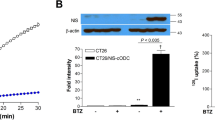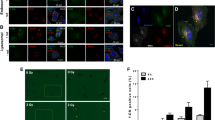Abstract
Meta-iodobenzylguanidine conjugated to 131I-iodine is an effective agent for the targeted radiotherapy of tumors of neural crest origin which express the noradrenaline transporter (NAT). The therapeutic application of 131I MIBG is presently limited to the treatment of phaeochromocytoma, neuroblastoma, carcinoid and medullary thyroid carcinoma. To determine the feasibility of MIBG targeting for a wider range of tumor types, we employed plasmid-mediated transfer of the NAT gene into a human glioblastoma cell line (UVW) which does not express the NAT gene. This resulted in a 15-fold increase in uptake of MIBG by the host cells. A dose-dependent toxicity of 131I MIBG to the transfectants was demonstrated using three methods: (1) survival of clonogens derived from monolayer culture; (2) survival of clonogens derived from disaggregated multicellular spheroids; and (3) spheroid growth delay. 131I MIBG was twice as toxic to cells in spheroids compared with those in monolayers, consistent with a greater effect of radiation cross-fire (radiological bystander effect) from 131I β-radiation in the three-dimensional tumor spheroids. The highest concentration of 131I MIBG tested (1 MBq/ml) was nontoxic to UVW control cells or spheroids transfected with the NAT gene in reverse orientation. These findings are encouraging for the development of NAT gene transfer-mediated 131I MIBG therapy.
This is a preview of subscription content, access via your institution
Access options
Subscribe to this journal
Receive 12 print issues and online access
$259.00 per year
only $21.58 per issue
Buy this article
- Purchase on Springer Link
- Instant access to full article PDF
Prices may be subject to local taxes which are calculated during checkout



Similar content being viewed by others
References
Wieland DM et al. Radiolabelled adrenergic neuron-blocking agents: adrenomedullary imaging with [131I]iodobenzylguanidine J Nucl Med 1980 21: 349–353
Jacques S Jr et al. Comparison of the sodium dependence of uptake of metaiodo-benzylguanidine and norephrine into cultured bovine adrenomedullary cells Mol Pharmacol 1984 26: 539–546
Troncone L, Rufini V . I-131-MIBG therapy of neural crest tumours (review) Anticancer Res 1997 17: 1823–1831
Feine U, Muller-Schauenburg W, Treuner J, Klingebiel T . Meta-iodobenzylguanidine (MIBG) labelled with 123I/123I in neuroblastoma diagnosis and follow up treatment, with a review of the diagnostic results of the international workshop of paediatric oncology held in Rome, September 1986 Med Pediatr Oncol 1987 15: 181–187
Shapiro B et al. Iodine-131I metaiodobenzylguanidine for the locating of suspected phaeochromocytoma: experience in 400 cases J Nucl Med 1985 26: 576–585
Konings JE et al. Diagnosis and treatment of malignant phaeochromocytoma with [131I]MIBG Radiother Oncol 1990 17: 103–108
Voute PA et al. Results of treatment with [131I]metaiodobenzylguanidine in patients with neuroblastoma. Future prospects of zetotherapy. In: Evans AE, D’Angio GJ, Knudson AG, Seeger RC (eds) . Advances in Neuroblastoma Research, 3rd edn Wiley-Liss: New York 1984 439–445
Lashford LS et al. Phase I/II study of iodine-131-metaiodobenzylguanidine in chemoresistant neuroblastoma: a United Kingdom Childrens Cancer Study Group investigation J Clin Oncol 1992 10: 1889–1896
Mairs RJ et al. The distribution of alternative agents for targeted radiotherapy within human neuroblastoma spheroids Br J Cancer 1991 63: 404–409
Cunningham SH et al. Radiotoxicity to neuroblastoma cells and spheroids of beta-, alpha- and Auger electron-emitting conjugates of benzylguanidine Br J Cancer 1998 77: 2061–2068
Lingen B, Bruss M, Bonisch H . Cloning and expression of the bovine sodium-and chlorine-dependent noradrenaline transporter FEBS Lett 1994 342: 235–238
Pacholczyk T, Blakely RD, Amara SG . Expression cloning of a cocaine- and anti-depressant-sensitive human noradrenaline transporter Nature 1991 350: 350–352
Glowniak JV et al. Evaluation of metaiodobenzylguanidine uptake by the noradrenaline, dopamine and serotonin transporters J Nucl Med 1993 34: 1140–1146
O’Donoghue JA et al. The implications of uptake of 131-meta-iodobonzylguanidine (MIBG) for the targeted radiotherapy of neuroblastoma Br J Radiol 1991 64: 428–434
Murray T, Hilditch TE . Therapeutic radionuclides. In: C Sampson (ed). Textbook of Radiopharmacy: Theory and Practice Chapman and Hall: London 1999 (in press
Roth JA, Cristiano RJ . Gene therapy for cancer: what have we done and where are we going? J Natl Cancer Inst 1997 89: 21–39
Buchsbaum DJ et al. Approaches to enhance cancer radiotherapy employing gene-transfer methods Gene Therapy 1996 3: 1042–1068
Raben D et al. Enhancement of radiolabeled antibody-binding and tumor-localization through adenoviral transduction of the human carcinoembryonic antigen gene Gene Therapy 1996 3: 567–580
Rogers BE et al. Tumor localization of a radiolabeled bombesin analogue in mice bearing human ovarian tumors induced to express the gastrin-releasing peptide receptor by an adenoviral vector Cancer 1997 80: 2419–2424
Rogers BE et al. Localization of iodine-125-mIP-Des-Met(14) bombesin (7-13)NH2 in ovarian carcinoma induced to express the gastrin releasing peptide receptor by adenoviral vector-mediated gene transfer J Nucl Med 1997 38: 1221–1229
Shimura H et al. Iodide uptake and experimental 131I thaerapy in transplanted undifferentiated thyroid cancer cells expressing the Na+/I symporter gene Endocrinology 1997 138: 4493–4496
Taurog A . Hormone synthesis: thyroid iodide metabolism. In: LE Braverman, Utiger RD (eds) . The Thyroid: A Fundimental and Clinical Text Lippincott-Raven: New York 1996 47–81
Neshasteh-Riz A et al. The implications of proliferative heterogeneity for the design of DNA-targeted radiotherapy: differential cytotoxicity of alternative radioiodoanalogues of IUdR to human glioma cells in monolayer or spheroid culture Br J Cancer 1998 77: 385–390
Strickland DK, Vaidyanathan G, Zalutsky MR . Cytotoxicity of alpha-particle-emitting m-[At-211] astatobenzylguanidine on human neuroblastoma-cells Cancer Res 1994 54: 5414–5419
Parr MJ et al. Tumor-selective transgene expression in vivo mediated by an E2F-responsive adenoviral vector Nature Med 1997 3: 1145–1149
Rampling R, Cruickshank G, MacLean A, Brown M . Therapeutic replication-competent herpes virus Nature Med 1998 4: 133
Jin BK et al. Prolonged in vivo gene expression driven by a tyrosine hydroxylase promoter in a defective herpes simplex virus amplicon vector Hum Gene Ther 1996 7: 2015–2024
Robert JJ, Geoffroy MC, Finiels F, Mallet J . An adenoviral vector-based system to study neuronal gene expression: analysis of the rat tyrosine hydroxylase promoter in cultured neurons J Neurochem 1997 68: 2152–2160
Song S et al. An HSV-1 vector containing the rat tyrosine hydroxylase promoter enhances both long-term and cell type-specific expression in the midbrain J Neurochem 1997 68: 1792–1803
Acknowledgements
We would like to thank Professor Heinz Bonisch and Dr Michael Bruss, University of Bonn, for the kind gift of the bovine noradrenaline transporter cDNA. This project was funded in part by the Department of Health, the Neuroblastoma Society, the British Urological Foundation, The European Community and the Cancer Research Campaign. Thanks also to Professor D Kirk, Department of Urology, Gartnavel Hospital and Professor A Barrett, Beatson Oncology Centre, Western Infirmary, for their support.
Author information
Authors and Affiliations
Rights and permissions
About this article
Cite this article
Boyd, M., Cunningham, S., Brown, M. et al. Noradrenaline transporter gene transfer for radiation cell kill by 131I meta-iodobenzylguanidine. Gene Ther 6, 1147–1152 (1999). https://doi.org/10.1038/sj.gt.3300905
Received:
Accepted:
Published:
Issue Date:
DOI: https://doi.org/10.1038/sj.gt.3300905
Keywords
This article is cited by
-
Inhibition of glycolysis and mitochondrial respiration promotes radiosensitisation of neuroblastoma and glioma cells
Cancer & Metabolism (2021)
-
Cotransfecting norepinephrine transporter and vesicular monoamine transporter 2 genes for increased retention of metaiodobenzylguanidine labeled with iodine 131 in malignant hepatocarcinoma cells
Frontiers of Medicine (2017)
-
An evaluation in vitro of PARP-1 inhibitors, rucaparib and olaparib, as radiosensitisers for the treatment of neuroblastoma
BMC Cancer (2016)
-
I-131-mIBG therapy in neuroblastoma: established role and prospective applications
Clinical and Translational Imaging (2016)
-
Radiosensitization of noradrenaline transporter-expressing tumour cells by proteasome inhibitors and the role of reactive oxygen species
EJNMMI Research (2013)



